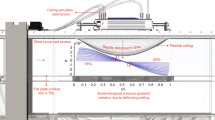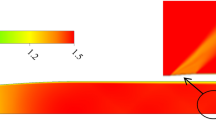Abstract
Presented are results from a parametric investigation of wind-tunnel test-section configurations with a goal of stabilization of normal-shock-wave structure. The test section includes a two-flow-passage arrangement, where each passage is separated by a shock-wave-holding plate. The top wall for the top passage is contoured relative to the streamwise-flow direction, and a choking flap is located at the downstream portion of the bottom flow passage. Altered are the streamwise and spanwise positions of the shock-wave-holding plate, angle of the choking flap, and amount of venting. Of interest are shadowgraph flow visualization images, grayscale spectral energy variations, and integrated grayscale spectral energy levels. Higher static-pressure ratio downstream of the shock wave (caused by higher choking-flap angle, lower shock-wave-holding-plate position, and less venting) is associated with greater shock-wave-standoff distance (relative to the shock-wave-holding plate) and decreased flow unsteadiness. The most optimal arrangement includes a stabilized normal shock wave and lambda foot, which are largely two dimensional over the shadowgraph visualization volume.














Similar content being viewed by others
Abbreviations
- A :
-
Flow passage area
- A*:
-
Area in flow passage where Mach number is 1
- A min :
-
Minimum area in flow passage
- d :
-
Distance from test-section entrance to the shock-wave-holding-plate tip
- f :
-
Frequency
- Δf :
-
Frequency resolution
- F s :
-
Sampling frequency
- \( {\mathcal{F}} \) :
-
Fast Fourier transform function operator
- GS:
-
Grayscale value
- h :
-
Distance from the bottom wall to the shock-wave-holding plate
- \( \dot{m} \) :
-
Overall mass flow rate
- \( \dot{m}_{\text{b}} \) :
-
Mass flow rate in bottom flow passage
- \( \dot{m}_{\text{t}} \) :
-
Mass flow rate in top flow passage
- N :
-
Number of frames
- P e :
-
Static pressure in exhaust plenum
- P s :
-
Local static pressure in the test section
- P t :
-
Stagnation pressure at entrance of test section
- Str :
-
Strouhal number \( 2\pi f\delta/u_{\infty } \)
- t :
-
Time
- \( u_{\infty } \) :
-
Freestream velocity at entrance of test section
- θ :
-
Angle of the choking flap
- \( {\delta} \) :
-
Boundary layer thickness at entrance of test section
- y(t):
-
Digitized filtered time sequence at one pixel location
- Y(f):
-
Normalized Fourier transform of y(t)
References
Sajben, M., Kroutil, J.C.: Effects of initial boundary-layer thickness on transonic diffuser flows. AIAA J. 19, 1386–1393 (1981). https://doi.org/10.2514/3.60075
Bogar, T.J., Sajben, M., Kroutil, J.C.: Characteristic frequencies of transonic diffuser flow oscillations. AIAA J. 21, 1232–1240 (1983). https://doi.org/10.2514/3.8234
Robinet, J.C., Casalis, G.: Shock oscillations in diffuser modeled by a selective noise amplification. AIAA J. 37, 453–459 (1999). https://doi.org/10.2514/2.755
Handa, T., Masudo, M., Matsuo, K.: Mechanism of shock wave oscillation in transonic diffusers. AIAA J. 41, 64–70 (2003). https://doi.org/10.2514/2.1914
Edwards, J.A., Squire, L.C.: An experimental study of the interaction of an unsteady shock with a turbulent boundary layer at Mach numbers of 1.3 and 1.5. Aero J. 97, 337–348 (1993). https://doi.org/10.1017/S000192400002666X
Ott, P., Bölcs, A., Fransson, T.H.: Experimental and numerical study of the time-dependent pressure response of a shock wave oscillating in a nozzle. J. Turbomach. 117, 106–114 (1995). https://doi.org/10.1115/1.2835625
Bur, R., Benay, R., Galli, A., Berthouze, P.: Experimental and numerical study of forced shock-wave oscillations in a transonic channel. Aerosp. Sci. Technol. 10, 265–278 (2006). https://doi.org/10.1016/j.ast.2005.12.002
Bruce, P.J.K., Babinsky, H.: Unsteady shock wave dynamics. J. Fluid Mech. 603, 463–473 (2008). https://doi.org/10.1017/S0022112008001195
Ogawa, H., Babinsky, H.: Wind-tunnel setup for investigations of normal shock wave/boundary-layer interaction control. AIAA J. 44, 2803–2805 (2006). https://doi.org/10.2514/1.24370
Moffat, R.J.: Describing the uncertainties in experimental results. Exp. Therm. Fluid Sci. 1(1), 3–17 (1988). https://doi.org/10.1016/0894-1777(88)90043-X
John, J.E.A.: Gas Dynamics, 2nd edn. Allyn and Bacon Inc., Newton (1984)
Acknowledgements
The Alabama Innovation Fund (Contract ID No. 61070000002), the University of Alabama Endowment Fund, and the Office of the Vice President for Research and Economic Development of the University of Alabama in Huntsville are acknowledged for financial support for the research which is reported in the present paper. The following individuals are also acknowledged for their assistance with laboratory development, laboratory testing, laboratory instrumentation and apparatus, and/or data analysis: Tony Hall, David Lineberry, Andrew Miller, Melissa Anderson, Robert Pertrimoulx, Daniel Corey, Soo Rhee, Conner Gisburne, Kaylee Hall, Sarah Stearman, Benjamin Shea, Benjamin Lund, Patrick McInturff, Connor Pierce, and Warren Buzzard.
Author information
Authors and Affiliations
Corresponding author
Additional information
Communicated by A. Higgins.
Publisher’s Note
Springer Nature remains neutral with regard to jurisdictional claims in published maps and institutional affiliations.
Rights and permissions
About this article
Cite this article
Ligrani, P.M., Marko, S.M. Parametric study of wind tunnel test section configurations for stabilizing normal shock wave structure. Shock Waves 30, 77–90 (2020). https://doi.org/10.1007/s00193-019-00911-5
Received:
Revised:
Accepted:
Published:
Issue Date:
DOI: https://doi.org/10.1007/s00193-019-00911-5




